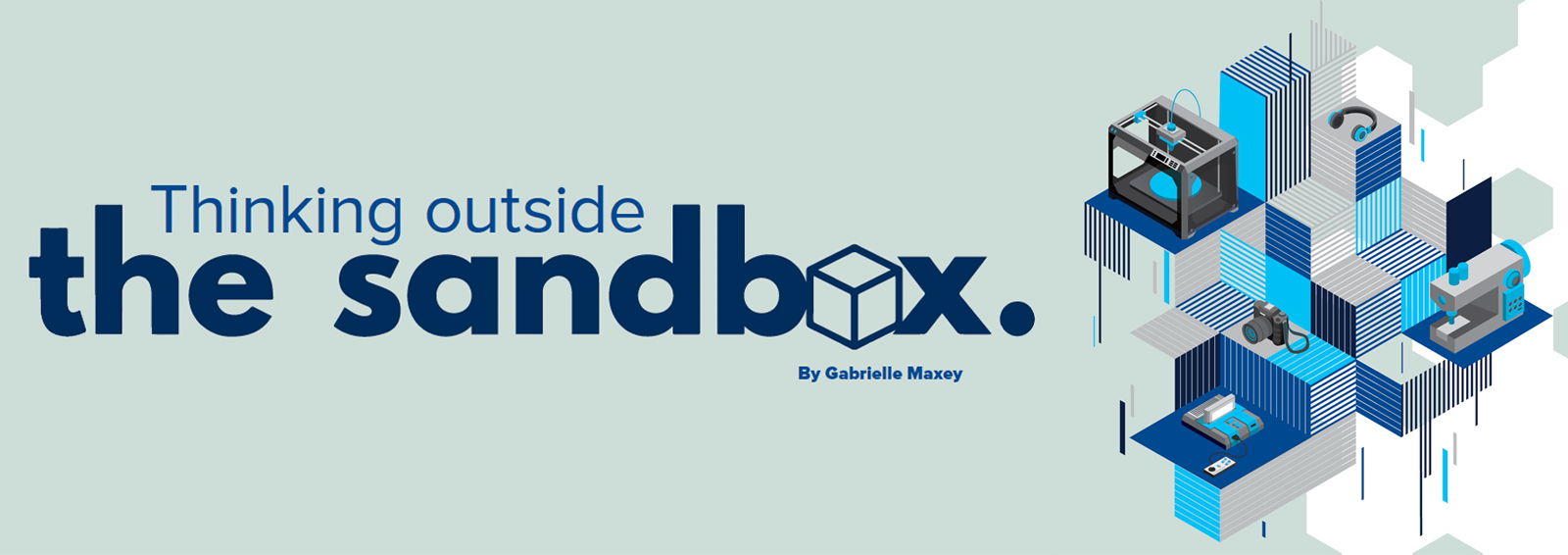Visit the Ned McWherter Library and you can feel the vibe of the Sandbox, the University’s collaborative creator space. 3D printing, laser cutting, photography, music, video and audio production, presentation practice — students, faculty and staff can do it all there. And while many of those resources will be limited this semester due to COVID-19, and workshops may be canceled, there are still plenty of opportunities for the campus community to express its creativity.
It started in 2014 when Cody Behles, then an emerging technology librarian at McWherter Library and now with the FedEx Institute of Technology, established the Technology Sandbox in the first-floor commons area. It had 3D printers as well as a workshop area and video game corner.
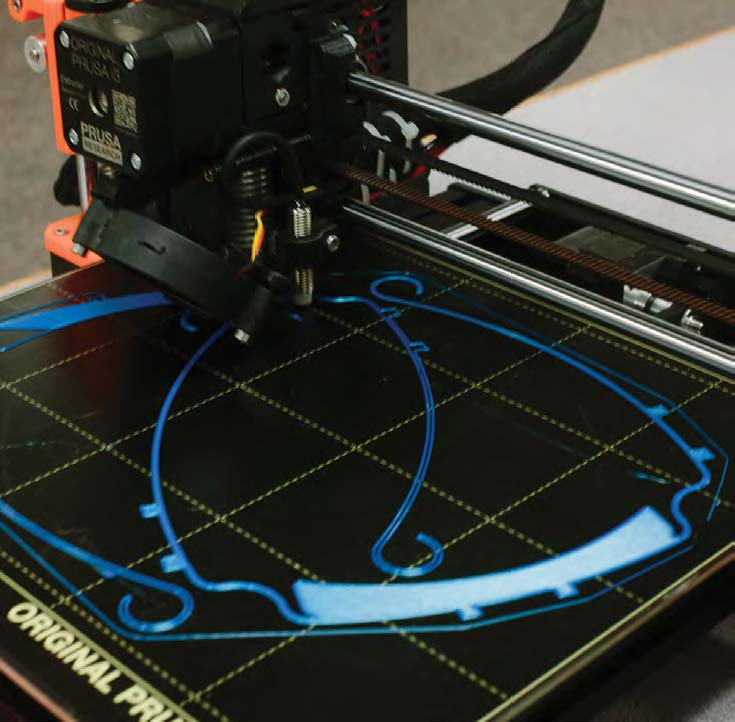 After Behles moved to FIT, Casey Parkman took over the 3D printing and workshops.
In fall 2017, he and other library staffers formed a committee to create a makerspace
in the library.
After Behles moved to FIT, Casey Parkman took over the 3D printing and workshops.
In fall 2017, he and other library staffers formed a committee to create a makerspace
in the library.
“We pitched the idea to the head of the library in spring 2018 to move the Technology Sandbox into the Reserves Room, as well as expanding the resources and offering more events and cool tech,” said Parkman, a library staffer who manages the Sandbox and circulating technology. “We moved everything that summer and changed the name to just the Sandbox with everything being fully available for students that fall.”
Today the Sandbox has two active 3D printers, a Brother sewing machine and a laser cutter among its tools.
“With the sewing machine, you could make anything from clothing to pillows to bags or purses,” Parkman said. “These days a good project idea for that would be to make masks during the pandemic. At one of our Maker Monday events, we sewed stress dolls for finals week. Students were able to take a pattern we designed and make their own stuffed doll, and some even created their own patterns to sew.”
There’s a 49-key MIDI keyboard that can be used to compose music, make beats to add to tracks and build songs or create sound effects for videos. Users can learn how to play the piano and there are tutorial programs at various levels of experience that can teach through the keyboard.
The Glowforge laser cutter has a seemingly endless number of project possibilities.
“Users in the Sandbox have made puzzles, treasure boxes, 3D animal models, balsa wood airplanes, keychains, board game pieces, maps and name plaques,” said Parkman. “Users have also engraved cutting boards with recipes, made Christmas ornaments, engraved photographs and comic strips into ceramic tiles and built parts for small machines.”
Professor Georgia Creson, head of the Visual Merchandising and Exhibition Design concentration in the College of Professional and Liberal Studies, brought her Strategic Design for Residential Spaces class over to work on a project using the laser cutter throughout the fall 2019 semester.
“The month-long assignment was to create a floorplan in Photoshop or SketchUp, transfer it to the Glowforge software and then cut the design out of board,” Creson said. “Students then filled their 3D ‘houses’ with laser-cut furniture and decorative elements to show their designs as miniature models.
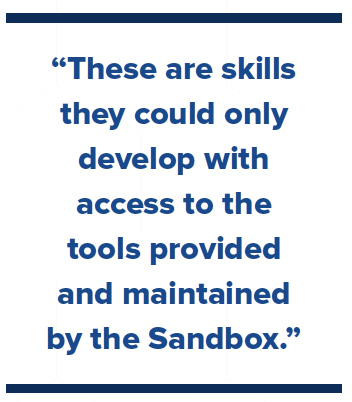 “As future designers, I think having the ability to use these tools is very valuable.
With their knowledge of laser cutters and 3D printers, they could explore entry-level
roles in fabrication, creating prototypes, building architectural models and making
displays for retail and exhibition spaces. These are skills they could only develop
with access to the tools provided and maintained by the Sandbox.”
“As future designers, I think having the ability to use these tools is very valuable.
With their knowledge of laser cutters and 3D printers, they could explore entry-level
roles in fabrication, creating prototypes, building architectural models and making
displays for retail and exhibition spaces. These are skills they could only develop
with access to the tools provided and maintained by the Sandbox.”
The Video and Presentation Practice Studios are both designed for use as actual sets. There are backdrops in a choice of green, white and black. Both rooms have lighting, tripods and other materials to help with video recording. The Video Studio has additional lighting options: the Presentation Studio has a whiteboard, projection screen and a mobile lectern. Students can check out a wide range of cameras (DSLR, camcorders, GoPros), microphones and other equipment.
The Audio Studio is set up with four microphones, a mixing board and a digital recorder for students to record podcasts. Every studio has a computer with plenty of software for recording, editing and producing. Students have recorded interviews and presentations for their classes.
In 2018, 500-600 people used the Sandbox each semester. By fall 2019, the number had grown to 2,000-2,500 users.
“Probably 98% were students, the other 2% were faculty, staff and some community users,” said Parkman.
Caleb Suggs, executive producer of Tiger News, was so blown away that he did a story on the Sandbox for his show.
“I mean, honestly — a video production room, an audio studio, a 3D printer — the Sandbox is really paradise for creative people,” Suggs said. “It’s a huge benefit for anyone who wants to express themselves or make something — whether it be music, visual art, video games, movies, you name it — especially if they don't have the money, resources or space to do so on their own.
“I think the Sandbox might be one of my favorite spots on campus because of the cool atmosphere, the kind staff and the incredible tools that a creative like myself loves to have available.”
“We’ve had students and faculty alike tell us how happy they were to have the Sandbox available because so many of the resources we offer are either hard to find out in the real world or prohibitively expensive,” said Parkman. “We want to have creative tools for users to be able to make unique projects that stand out and get noticed to hopefully lead to their success in their classes and careers.
“We’ve had such a wide range of projects and users over the past couple of years, with a lot of positive feedback on their work. The biggest impact to me is the students who have come back in specifically to show me how they integrated their Sandbox project into their class assignment and received a great grade on it. That’s meant a lot to me.”
SANDBOX AND TECH COMMUNITY PARTNER TO FIGHT COVID WITH PPE
The Sandbox is also part of an effort that has been supplying Personal Protective Equipment (PPE) to the community during the COVID-19 health emergency.
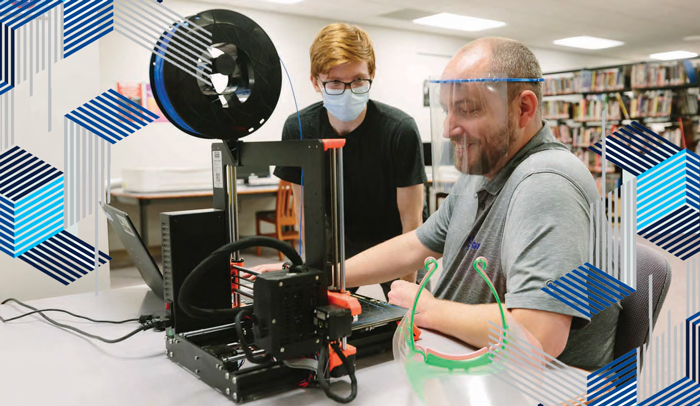 Claudio Donndelinger, emerging technology research specialist at the FedEx Institute
of Technology, helped put out the word in March. A network of around 45 volunteers
with 3D printers from the technical community responded, producing more than 24,000
face shield frames as of late July. The initiative was facilitated by nonprofit Mid-South
Makers and led to the formation of the Memphis Fighting COVID team. The Sandbox and
other members of the UofM tech community have contributed about 1,200 face shields
to that total.
Claudio Donndelinger, emerging technology research specialist at the FedEx Institute
of Technology, helped put out the word in March. A network of around 45 volunteers
with 3D printers from the technical community responded, producing more than 24,000
face shield frames as of late July. The initiative was facilitated by nonprofit Mid-South
Makers and led to the formation of the Memphis Fighting COVID team. The Sandbox and
other members of the UofM tech community have contributed about 1,200 face shields
to that total.
“We use distributed manufacturing,” Donndelinger explained. “3D printing is good about enabling that idea. You have a 3D printer and take it out of your office, bring it to your desk and have it running in the background while you’re doing other things. It’s a very background-friendly activity.”
While there are literally hundreds of face shield patterns, the Memphis Fighting COVID team settled on three or four designs.
“They’re rather quick to print,” he said. “While some might take two to three hours, on our printers it takes 15 minutes to an hour and a half. We have smaller material costs, a smaller amount of materials used and print out more frames in a shorter amount of time.”
The team has donated the face shields to Memphis Medical Society, doctors’ offices, clinics, health care facilities and the Shelby County Sheriff’s Department.
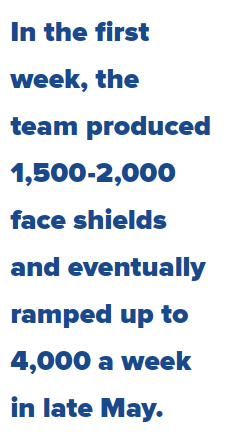 In the first week, the team produced 1,500-2,000 face shields and eventually ramped
up to 4,000 a week in late May. The volunteers printed the frames and used office
transparencies for the shield. Soon the need outpaced the number of volunteers available
to assemble the face shields, so they transitioned to making kits that included the
frame, shield and assembly instructions.
In the first week, the team produced 1,500-2,000 face shields and eventually ramped
up to 4,000 a week in late May. The volunteers printed the frames and used office
transparencies for the shield. Soon the need outpaced the number of volunteers available
to assemble the face shields, so they transitioned to making kits that included the
frame, shield and assembly instructions.
“The members of the Memphis tech community joined the Memphis Fighting COVID team because we’re all driven by doing and want to make an impact,” said Donndelinger. “We’re all techy, nerdy folks. When we face a problem, we want to solve it.”
The group is also producing full-face shields for the UofM’s IT Service Desk and for a school in Marshall County, Miss.
“It feels good to help out, and I'm glad there’s something we can do to help the cause,” said student Michael Porter, who is helping with the effort. “I would encourage others to do what they can as well. Even if they don’t have 3D printers, there are all sorts of ways to contribute like making cloth masks or assisting the vulnerable people in your life.”

